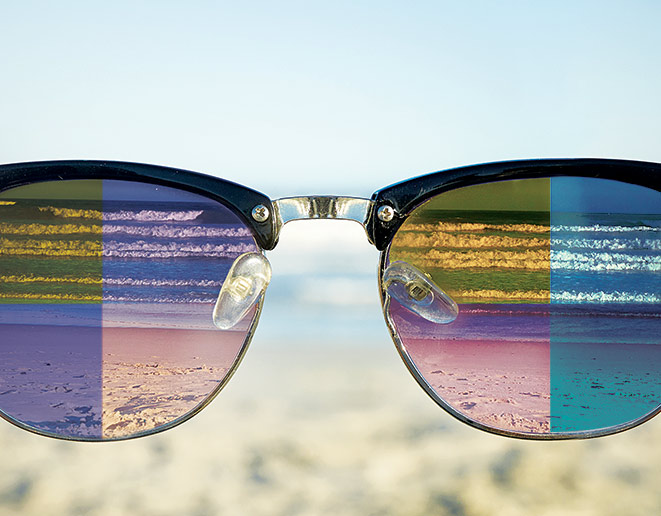
By Alex Yoho, ABOM
Function and style are the essential characteristics of any quality sun lens. But sunwear makers are bringing an exciting new element to the mix—color enhancement—and it’s adding new dimensions to both function and style. Even the most articulate patients are reduced to “Wow!” when they experience the effects of these lenses.
Color-enhancing lenses from sunwear leaders such as Costa, Essilor, Ray-Ban, Smith Optics, Maui Jim and Zeiss are changing the way we see the world by making colors “pop.” The lenses use filter tints, coatings and polarizers to manipulate various bands within the color spectrum, which then affects how we perceive color.
GETTING A FEEL FOR COLOR
Different lens colors have always had their proponents because of the way things “feel.” This feel is due to the effect that various elements or oxides used in dyes and coatings absorb certain wavelengths of light and allow others to pass through.
Color perception starts with the color receptor cells in our retina, which are called cones. There are three distinct types of cones that each send a particular range of color information to our brain. The brain experiences the sensation of color in different ways which can vary a bit from person to person. When we use various absorptive lens materials to control these colors, the results can be profound.
Different lifestyle situations with different illumination in our surroundings also occur, so the manufacturers of color-enhancing lenses have to consider many possibilities which also require various tints and coatings to accomplish their goals. Let’s take a look at the methods that lens makers use to make particular colors seem to pop.
MAKING COLORS ‘POP’
One method using coatings is the use of bandpass filter technology. These coatings reflect all but a specific wavelength of the spectrum through the coating. My first experience using these was a gentleman who was a traveling salesman with an interesting dilemma. He was colorblind and could not differentiate traffic light colors. This is not usually a problem since it is universal that the red light is on top and the green light is on the bottom, but while traveling through certain small towns, he discovered that they mounted the signals horizontally, and he couldn’t be sure which light was a particular color. The answer was the use of bandpass filters; one for green and one for red. These were mounted high in his lens so when he came to a signal, he could distinguish which filter was letting light through and able to obey the signal.
Using coatings like the scientific grade, critically narrow bandpass that I used in this situation would not be conducive to use in sunwear. But this similar technology allowing a broader spectrum could be used in selectively promoting or attenuating certain colors.
Absorptive dyes can also control certain colors and may be used to promote others. An example of this would be the blue-blocking lenses. These have an apparent contrast enhancement due to removing the blue to violet end of the spectrum which does not focus well and scatters within the eye, causing glare. Color-enhancing lenses typically attenuate blue light to some degree, but not completely. Weeding out the high-energy blue light is important to eye health, but eliminating all blue light can have a detrimental effect on our circadian rhythms, causing sleep problems. Since these lenses make certain colors more vivid, it is also important not to remove all of the blue since this significantly changes the natural perception of color.
You might wonder why some color-enhancing lenses seem to have such tremendous contrast. To begin, we need to remember that though these lenses seem to amplify colors, they actually do not. Just like any sun lens, they are designed to reduce the amount of light coming through the lens. The apparent contrast enhancement comes from reducing certain parts of the spectrum more than others. The colors that are promoted most are in the range that the particular cone receptor is most sensitive. This is what makes those colors seem brighter.
It is inarguable that these lenses are controlling the spectrum in ways that we have not seen before and appear to give more definition to the world around us. Contrast sensitivity is a term that is used when we discuss them, but contrast sensitivity refers to the visual systems’ ability to distinguish light from dark. With sunwear we are reducing the amount of light, so contrast sensitivity is also naturally reduced. What these lenses are doing is promoting the particular colors in the spectrum that the eye is most sensitive to, which allows a distinction between colors. In other words, “color contrast” might be a better descriptive term. This distinction results in the brain’s ability to recognize things that may not normally be picked up.
WHEN IT COMES TO COLOR, SOMETIMES LESS IS MORE
The reduction of other areas of the spectrum that the cones are not as sensitive to is as important as promoting the colors to which they are sensitive. By reducing these areas of the spectrum, the information sent to the brain is more differentiated, which makes the promoted colors much more distinct. This is very much like picking up the trash in a heavily traveled garden. The flowers are much more noticeable without the distraction of trash.
Speaking of trash, these lenses are masterful in glare reduction, and glare is some of the worse optical trash there is. Polarized filters by themselves eliminate glare and make vision crisp. Most of the color-enhancing lenses on the market make good use of this aspect and have developed their own polarizers that work hand in hand with the filtering technologies to put even more pizazz into the equation.
Polarizers are not ideal in every situation. If you provide a pilot with polarized lenses, you could be endangering their life since many of their flight instruments are also polarized in a different direction. Think of the old test for polarized lenses by looking through them overlapped and at 90 degrees from each other. They black out almost all the light which is exactly what happens to pilots. Many automobiles also have digital instruments that can cause this dilemma.
Sunwear manufacturers who are developing color-enhancing lenses are addressing this. With selective filtering, they can offer many different options for various situations which opens a tremendous opportunity to address various lifestyle needs. For example, a golfer may be more comfortable walking around in a traditional polarized lens, but when it comes to actually playing the game, they would benefit more from a non-polarized lens that reduces the overall light, but promotes greens and browns to more accurately read the undulations of the green.
Various manufacturers also have differing philosophies on how they approach these options. One manufacturer removes more of the yellow spectrum to which the eye is most sensitive, allowing other colors to be more recognized. Others filter out the colors in between the most sensitive to allow the peak sensitive colors to pop out. Yet others balance the intensity of colors to provide a good rendition of all colors. As with all sunwear, beauty is in the eye of the beholder. Although all the sunglass makers have valid theories on what makes the perfect solution for a particular lifestyle, the patient’s sense of which “feels” right will still take priority.
TIPS FOR DISPENSING COLOR-ENHANCING SUNWEAR
As you design the optimum sunwear for your patient, there are a number of factors to consider. First, eliminate UV which affects the cornea and crystalline lens by breaking chemical bonds and causing permanent damage. Most eyewear of any type has reduced UV, but we need to be sure.
Next, be sure to choose products that attenuate HEV (High-Energy Visible) light in the violet-blue range of the spectrum which may have a detrimental effect on the retina. Keep in mind that some blue light is beneficial and that eliminating too much of it can distort colors.
Various filtering tints may be added to reduce the particular wavelength desired and reduce the amount of light desired. Gradient tints are easily done and have the advantage of allowing a clearer view below with the sunlight reduced on top.
Use polarization when it’s appropriate (most of the time) to reduce glare such as around water, snow or driving (with analog instruments). Polarization is far superior for most glare problems and should be used anytime their lifestyle needs warrant its use.
Anti-reflection coatings should always be used. Since a dark lens is highly reflective, backside coatings eliminate surface reflections from behind. AR can be applied to the front side as well when the patient would benefit from a slightly lighter lens.
Mirror coatings can have the opposite effect and actually reduce light transmittance by reflecting it away from the lens. They will also provide a fashion statement due to the many color options available that many find appealing.
Obviously, these options are used and combined every day as we design sunwear for our patients. The great thing about color-enhancing lenses is that they often incorporate all or most of these options at once, providing superior vision for fun in the sun.■
Alex Yoho is an expert optician and optical educator.












